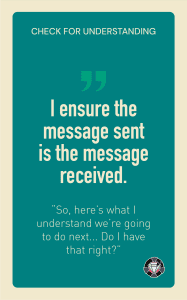Clarity is key to better collaboration and more productive workplace conflict.
Great teams know where they’re going, and need each other to be successful. Easy to say. Harder to do. Today in our “Great Teamwork Series”, we share 12 collaboration habits to help get (and keep) everyone on the same page. You can use these habits to assess how you’re showing up to influence your team. Or share it with your team to identify opportunities to make your good team even better.
12 Habits Great Teams Consistently Do to Create Better Clarity and Collaboration
1. Define Success: Visualize and articulate your vision for a desired future
Habit: I establish clear outcomes and expectations.

Engage others on your team by asking, “What does winning truly look like?” Great teams don’t assume everyone’s on the same page. They take time to describe the desired future with specific goals, expectations, and measurements of success.
Related Article: How to Build a Great Team Culture
2. Know What Matters Most: Understand how your work connects to the bigger picture
Habit: I seek out the bigger why behind any task.
Before you can make meaning (see Habit 3 below), understand the bigger why.
3. Make Meaning: Establish a bridge between daily tasks and overarching objectives

Habit: I help connect the work we do to the bigger picture
Great teams don’t just perform tasks; they delve into the “why” behind their work. They seek a deeper understanding and purpose. Be sure you and your teammates can finish this sentence. “This (work, project, process, procedure) is so important because…”
4. Set Clear Expectations: Articulate a clear definition of success
Habit: I communicate clear and specific expectations.
One good conversation about expectations prevents fourteen “why didn’t you” conversations. One secret to better collaboration is clear expectations.
Related Article: Creating Clarity: Strategic Activities for Human-Centered Leaders
5. Communicate Consistently: Vary communication to break through distractions
Habit: I build a proactive communication plan to get everyone on the same page.
People make memories based on recency, recall, repetition, and emotion. If you want an important message to cut through distractions, communicate multiple times through different channels. Great teams prioritize communication.
Related Article: Remote Team Communication: How to Send Memorable Messages
6. Check For Understanding: Ensure the message you intend to send is the message received

Habit: I ensure the message sent is the message received.
You always make sense to you, but how do you know your team understood what you meant? How do you know you’ve understood what someone says to you? Good communication involves a feedback loop: a send and a receive.
Related Article: Check for Understanding: A Leadership Communication Best Practice
7. Schedule the Finish: Close the loop with a clear commitment
Habit: I confirm specific deliverables and timeframes for when we will follow up on commitments.
You’ve got more to do than time to do it. Your plan is going to get interrupted. Your interruptions are going to get interrupted. If you don’t have an intentional, focused way to finish what you start, it won’t happen. Great teams don’t leave accountability to chance or a heroic act of willpower. They set clear expectations about deliverables and timeframes.
Related Article: High ROI Leadership: Schedule the Finish
8. Prioritize What Matters Most: Spend time on activities that will have the biggest impact

Learn more about our Let’s Grow Leaders Synergy Stack Experience info@letsgrowleaders.com
Habit: I spend my time working on our most important things.
Great teams understand that there’s always an infinite need and finite me, so mind the MIT (most important thing). Want a great team? Prioritize activities and habits on what will have the biggest impact.
Related Article: Productivity at Work—How to Lead Highly Productive Teams
9. Clarify Others’ Interests: Understand what a successful outcome looks like for others
Habit: I seek to understand what matters most to others.
One easy way to foster collaboration is to ask, “What would a successful outcome look like for you?”
10. Look for Common Ground: Seek opportunities for alignment
Habit: I help people realize our shared objectives.
Great teams have a knack for finding common ground and using that as a starting point for collaboration.
11. Share Information and Best Practices: Proactively communicate helpful insights
Habit: I freely contribute what I know to make work easier for others.
Great teams build a habit of sharing what’s working. They look for ways to be helpful and to make one another’s work a bit lighter.
Related Article: How to Share Best Practices That Improve Results
12. Share Concerns: Initiate important conversations
Habit: You can count on me to tell you what’s on my heart and mind.
Collaborative teammates say what needs to be said and have the hard conversations sooner.
Related Article: How to Start the Conversation Everyone Wants to Avoid
13. Your Turn: What habit would you add to create better clarity and get everyone on the same page?
Note: This article is part two of our 4-part Better Teamwork series. Next up: Curiosity.
Related: Navigating Change: How the Holidays Can Help You Be a Better Leader


